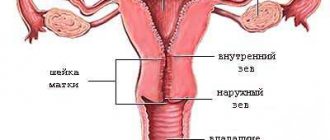Cervical cancer is a tumor formation that is malignant in nature. Localized in the cervix area. This form of tumor occupies a leading place among all cancers of the genital organs. Most often diagnosed in women aged 35-55 years. According to the international classification of diseases ICD-10, cervical cancer is coded C53. Depending on the location, the tumor is distinguished:
- C53.0 - internal part;
- C53.1 - outer part;
- C53.8 - lesion extending beyond the above areas;
- C53.9 - unspecified lesion.
The Yusupov Hospital is equipped with modern equipment that allows you to quickly and effectively diagnose cervical cancer even in the early stages of the development of the tumor process. Treatment of oncological diseases is carried out according to the latest European standards. For this purpose, high-quality medicines that meet safety criteria are used.
Risks of cervical cancer
Doctors identify predisposing factors, the presence of which increases the risk of developing cervical cancer. Among them:
- Burdened heredity. If someone in your family has been diagnosed with cervical cancer, subsequent generations of women are at risk.
- Smoking. Chronic intoxication increases the risk of developing cancer several times.
- Hormonal imbalance. Changes in hormone concentrations can provoke the formation of tumor foci.
- Promiscuous sexual intercourse. Frequent unprotected sex with different partners leads to HPV infection.
- Immunodeficiency. A decrease in the body’s protective functions does not allow it to cope with the HPV virus on its own. As a result, the risk of developing cervical cancer increases.
- Long-term use of hormonal contraceptives. When using COCs for more than 5 years, the possibility of tumor formation in the cervical area increases significantly. After stopping the drugs, the risks decrease.
- Complicated obstetric history. The more births a woman has had, the higher her risk of developing cervical cancer.
Expert opinion
Author:
Natalya Aleksandrovna Vyaznikova
Oncologist
Cervical cancer is diagnosed in 7% of women and 20% of older people. Its signs appear already at the initial stage. As the disease worsens, more and more symptoms appear. If you start therapy at the first stage, the probability of successfully getting rid of the disease is 95%. Over the past few years, deaths from cervical cancer have tripled. Women over 40 years of age are recommended to undergo an examination at least once a year. Cytological examination is one of the most effective ways to protect against cervical cancer. HPV vaccinations are also required.
Diagnosis of the appearance of a tumor is difficult because there are no clear signs. Recovery directly depends on the speed of detection of the tumor, so it is important to immediately contact the clinic if the first symptoms of the disease appear. At the Yusupov Hospital, thanks to high-tech equipment, cancer is detected in the early stages and comprehensive treatment is provided. After completion of therapy, the patient remains under the supervision of doctors in order to promptly identify possible recurrent metastases.
Organization of treatment in Germany
Very often, women travel to Germany to undergo treatment for cervical cancer in the best European clinics. But many do not receive quality treatment only because they do not know how to organize a trip, or the organization takes too much time and the disease progresses, moving to the next stage.
It is better not to delay the start of treatment. Contact ]Booking Health[/anchor]. We will help organize your trip to Germany as quickly as possible. We will take care of all organizational issues: we will help you obtain a visa, medical documents, book a hotel, and get to the clinic.
Thanks to Booking Health services you will have the opportunity to:
- Choose the best program at an affordable cost
- Save on insurance for foreign patients, which reaches 50% or more of the total cost of the program
- Continue remote communication with your doctor after completing therapy
With Booking Health, you save up to 70% of the money you would spend on treatment if you independently organized a trip to Germany.
Causes of cervical cancer
Human papillomavirus is one of the etiological factors in the occurrence of cervical cancer. The pathogen is diagnosed in the majority of the population. Sexual transmission is the main route of transmission of HPV. Its action is to malignize cells. As a result of the mutation, the tumor process spreads with the development of cervical cancer.
Doctors identify a number of precancerous conditions. Their untimely diagnosis and treatment increases the risk of tumor formation. Cervical cancer can occur due to:
- Pseudo-erosions. As a result of hormonal imbalance, the squamous epithelium of the vaginal part of the cervix is replaced by glandular epithelium.
- Injuries. The cervix can be injured as a result of childbirth or abortion. Scars form at the site of injury. These tissues tend to become malignant over time.
- Dysplasia. Changes that occur to cells increase the risk of cancer.
To identify precancerous diseases, it is necessary to regularly visit a gynecologist for preventive examinations.
Prevention is the only way to preserve health and life
Simple and accessible steps for any woman to prevent the occurrence of the disease:
- careful attention to your condition;
- mandatory regular examination by a gynecologist;
- use of barrier methods of contraception (condoms) to avoid infection with the papillomatosis virus;
- if barrier contraception is not possible, periodic (every six months) infection checks;
- vaccination (a modern vaccine against human papillomavirus has been developed and is available).
Remember that on one side of the scale is the effort, time, money spent, on the other is life.
For information about the causes of the disease and methods of prevention, watch the video:
This article has been verified by Olga Zorina, a current qualified physician, and can be considered a reliable source of information for site users.
Rate how helpful this article was
4 8 people voted, average rating 4
Did you like the article? Save it to your wall so you don’t lose it!
First symptoms and signs
The danger of cervical cancer lies in its long asymptomatic course. As the tumor focus grows, the first clinical signs appear. Cervical cancer can be detected in its early stages during regular preventive examinations or during examination for another disease. The main symptoms of carcinoma are:
- Increased period of menstrual bleeding.
- Pain. Their character is determined by the size of the tumor focus. The severity of pain varies from discomfort in the lower abdomen to severe pain radiating to the lumbar region.
- Bleeding from the vagina. Occurs after the onset of menopause, in the period between menstruation, during sexual intercourse or after examination in a gynecological chair. The amount of blood loss depends on the size of the tumor.
- Pathological discharge from the vagina. Cervical cancer may be accompanied by the appearance of foul-smelling leucorrhoea. Severe stages of the tumor, when it disintegrates, are characterized by discharge the color of meat slop.
- Weight loss. Rapid weight loss occurs as a result of decreased appetite.
- Increased body temperature. Hyperthermia is caused by an intoxication syndrome that occurs against the background of tumor growth.
- A sharp loss of strength, weakness. Cancer intoxication can be accompanied by headache, dizziness, and “fly spots” flashing before the eyes.
- Decreased libido. Occurs due to pain during sexual intercourse.
- Edema syndrome. Occurs due to the spread of the cancer process to the lymph nodes.
Price list
*Note:
Prices are indicated for foreign citizens. Citizens of the Republic of Belarus can receive medical services without charging a fee. Read more...
*Prices in Bel. rub. *You can view all types of services and exact prices on the page
| Procedure name | Price in Belarusian rubles |
| Wide local excision of vulvar tumor | 466 |
| Wide local excision of vaginal tumor | 708 |
| Unilateral adnexectomy | 578 |
| Bilateral adnexectomy | 1 025 |
| Bilateral adnexectomy, omentectomy | 1 156 |
| Bilateral adnexectomy, resection of the greater omentum, surgical staging | 1 268 |
| Subcutaneous vulvectomy | 727 |
| Separate diagnostic curettage | 186 |
| Hysterectomy without appendages | 1 454 |
| Panhysterectomy | 1 752 |
| Panhysterectomy, omentectomy | 2 181 |
| Panhysterectomy, pelvic peritonectomy, omentectomy | 4 362 |
| Wertheim operation (panhysterectomy with pelvic lymphadenectomy) | 3 206 |
| Wertheim operation with omentectomy | 3 486 |
| Wertheim operation (panhysterectomy with pelvic lymphadenectomy) with retroperitoneal lymphadenectomy | 4 362 |
| Vulvectomy with femoroinguinal lymphadenectomy through separate incisions | 3 095 |
| Vulvectomy with femoroinguinal-iliac lymphadenectomy through separate incisions | 3 542 |
| Monoblock vulvectomy with bilateral femoral-inguinal lymphadenectomy with vulvar plastic surgery using a combined method | 4 921 |
| Vulvectomy with femoroinguinal lymphadenectomy through separate incisions and vulvar plastic surgery with bilateral island infero-gluteal flaps | 4 921 |
| Vulvectomy with femoroinguinal lymphadenectomy through separate incisions and vulvar plastic surgery with a TRAM flap | 4 940 |
| Operation Sturmdorf | 1 025 |
| Knife biopsy of the cervix | 130 |
Diagnosis of cervical cancer
Cervical carcinoma requires a comprehensive diagnosis. The accuracy of the diagnosis depends on the quality of its implementation. The Yusupov Hospital has equipment that allows you to quickly and effectively determine the location of the tumor, the degree of its development and growth into surrounding tissues. Diagnosis of cervical cancer is as follows:
- Physical examination. The doctor conducts an examination in a gynecological chair. In this way, it is possible to establish the presence of abnormalities and suspect a tumor.
- General blood and urine analysis. Prescribed for the purpose of diagnosing the inflammatory process in the body, as well as anemic syndrome.
- Blood for tumor markers. SCC is a specific marker for squamous cell carcinoma of the cervix.
- Ultrasound of the pelvic organs. Allows you to establish the localization of the tumor, its size and the fact of germination into surrounding tissues.
- CT or MRI. Prescribed to identify metastatic foci.
- Colposcopy. The study allows you to assess the condition of the mucous membranes, as well as the size of the tumor focus.
- Biopsy. Cervical cancer cannot be determined without performing a histological examination of the biopsy specimen. The type of tumor is diagnosed in this way.
- PET-CT. Using a contrast study, a series of images is taken. They make it possible to determine the location of the tumor, its size, and metastatic foci.
Structure of the uterus
The content of the article
It is a muscular hollow organ. Its main function is to ensure conception, bearing a child, as well as the process of childbirth. Its dimensions are approximately 10 by 5 cm. During pregnancy, the volume increases up to 100 times. This is ensured by the elasticity of tissues and the ability of cells in the muscle layer to divide.
Macroscopically, it has a body, a bottom and a neck. The triangular body is directed with the base (bottom) upward. The side surfaces of the base have holes for the Fallopian tubes. In relation to the neck, it is located at an obtuse angle (slightly tilted forward). Changing the value of this angle can create problems during conception and gestation.
The cervix is its third part, located in the vaginal cavity. It has the shape of a cylinder, closer to conical for women who have not given birth. The gap inside is called the cervical canal. The inlet of the neck is the external pharynx, and the outlet is the internal.
The part of the cervix that faces the vagina is covered with stratified squamous epithelium without keratinization. The wall of the cervical canal is lined with glandular epithelium, which produces mucous secretion. This secret is needed for moisturizing the mucous membrane, mechanical cleaning, protection against pathogenic microorganisms (contains enzymes with antibacterial activity).
The wall of the organ has a layered structure:
- the inner layer, the endometrium, is a mucous membrane in which the glands are located;
- the middle layer is the myometrium, represented by a wide layer of smooth muscle tissue;
- external - perimeter, connective tissue covering, provides density and gliding relative to other organs.
The uterus is attached to the walls of the pelvic cavity by several ligaments. In the thickness of one of them (the broad ligament) are the Fallopian tubes. Their outer end opens into the abdominal cavity next to the ovaries. The diameter does not exceed half a centimeter, the inner surface is lined with ciliated epithelium, the function is to conduct the egg from the ovary to the uterine cavity.
The ovaries are glands that are classified as organs of the reproductive and endocrine systems. They consist of follicles within which the maturation of eggs occurs. They also produce female hormones (estrogens and progestins).
Cervical cancer treatment
Comprehensive treatment for cervical cancer includes:
- Surgical intervention. The extent of the operation is determined individually depending on the stage and size of the tumor.
- Radiation therapy. It is carried out as an independent method of treatment or in combination with other methods. The goal is to reduce the size of the tumor. Brachytherapy is a modern method of radiation. It is the most gentle method of radiation exposure.
- Chemotherapy. May be prescribed before or after surgery. Chemotherapy is used as a palliative treatment for inoperable cancer.
- Symptomatic therapy. Its main goal is to alleviate the general condition. Medicines are selected individually depending on the symptoms present.
- Diet.
Complications after surgery
- a woman is unable to become pregnant (except for intervention in the form of conization);
- possible inability to have sexual intercourse;
- deterioration of condition due to chemotherapy and radiation therapy;
- hormonal imbalance, if the doctor is forced to remove the ovaries.
Complications in case of refusal of surgery:
- bleeding;
- fistulas between organs;
- thrombosis;
- compression of the ureters with subsequent impairment of renal function.
Stages and prognosis
Determining the stage of cervical cancer is necessary to prescribe effective treatment. Depending on the main characteristics of the tumor, there are:
Stage 0 (Tis, N0, M0). Cancer cells do not penetrate into the underlying tissues, but are found only on the surface of the cervix.
Stage I (T1, N0, M0). The tumor has not spread beyond the cervix. The cancer process does not affect nearby lymph nodes.
- Stage IA (T1a, N0, M0). The tumor spreads deeper by less than 5 mm.
- Stage IB (T1b, N0, M0). The cancerous process spreads more than 5 mm deep into the tissue.
Stage II (T2, N0, M0). The tumor spreads beyond the cervix, but does not affect the walls of the pelvis and the lower third of the vagina.
Stage III (T3, N0, M0). Cervical cancer affects the wall of the pelvis or the lower third of the vagina. In this case, regional lymph nodes are affected. Metastatic foci are not detected.
Stage IV. A severe stage, which is characterized by the identification of foci of metastases. The tumor grows beyond the pelvis and affects nearby lymph nodes and organs (bladder, rectum).
Life expectancy after diagnosis of cervical cancer depends on many factors. Among them:
- stage of development of the pathology;
- quality of treatment provided;
- the presence of concomitant diseases that aggravate the course of cancer.
If the disease is detected in the early stages, complete recovery is possible. Unfortunately, it is extremely rare to detect cervical cancer in the early stages.
Statistics
According to WHO, in developing countries, cervical cancer confidently ranks second in the number of cancer diseases in women. It is second in prevalence to breast cancer. In total, several hundred thousand women die from this disease every year in the world (for example, in 2021 this was more than 300 thousand patients). On average, the disease reduces the life expectancy of affected women by 20-30 years.
But at the same time, it is important to remember that if the disease is detected early, the prognosis is much more favorable than with other types of cancer. So in this case, a lot also depends on the patient herself.
Relapse and treatment tactics
The frequency of recurrence of cervical cancer depends on the nature of the disease and the stage at which it was diagnosed. The treatment performed plays an important role in reducing the risk of recurrence of the disease. In the early stages of cervical cancer, complete recovery is possible. Severe stages often require palliative treatment.
The treatment tactics for relapses are no different from the treatment of the underlying disease. Doctors focus on the localization of the lesion, its size, stage of development and the degree of growth into surrounding tissues.
Indications for referral to colposcopy
- High degree of abnormalities detected by cytology.
- Persistent low grade or unsatisfactory cytology results.
- Cytology showed the presence of AGUS (atypical glandulocytes of undetermined significance).
- Suspicious appearance of the cervix during visual examination.
Basic instruments for colposcopy
- Colposcope with 6-16 times magnification
- Bright lighting with adjustable position
- Focal length 250mm for instruments
- Solutions:
- saline solution, 3-5% acetic acid, Lugol's solution
Colposcopic picture
Prevention of cervical cancer
In order to minimize the risk of developing cervical cancer, doctors have developed preventive recommendations. These include:
- Regular examination by a gynecologist. For timely diagnosis of pathologies of the pelvic organs, it is enough to visit a doctor twice a year.
- To give up smoking. Chronic intoxication negatively affects the condition of the entire body, provoking the development of tumors.
- Elimination of promiscuity. Regular sex with one partner reduces the risk of cervical cancer.
- Rational and balanced nutrition. The daily menu should contain vegetables, fruits, and herbs. Fatty and fried foods are excluded from the diet.
- Maintain personal hygiene. In this way, it is possible to minimize the risk of developing inflammatory diseases of the pelvic organs.
- Timely correction of hormonal levels. Hormone imbalance is a trigger for cervical cancer. Therefore, the disorder must be diagnosed and treated in a timely manner.
If you need to undergo a gynecological examination in Moscow, we recommend that you contact the Yusupov Hospital. The clinic has modern equipment. It allows you to diagnose cervical cancer in the early stages of the disease. An individual approach to each patient, affordable prices and quality services are the advantages of the Yusupov Hospital. To schedule a consultation, please call. You can also leave a request on the official website of the hospital. Administrators will contact you to clarify the details of the recording.
Is it possible to cure the disease?
The success of treatment is closely related to the timing of cancer detection. When detected at an early stage, the disease can in most cases be cured, and it is often possible to even preserve the ability to bear children.
The further the process goes, the lower the effectiveness of possible treatment.
If the cancer has not grown beyond the cervix and is located in a small area, the operation is limited to conization of the affected cervix, the appendages and uterus remain intact. In this case, the woman can maintain reproductive function.
If the situation is complicated by a large spread, the uterus is amputated with or without the ovaries. Additionally, lymph node dissection may be performed.
Surgery is combined with chemotherapy or radiation therapy at the doctor's discretion. It has been proven that the combination of these methods with surgery gives a favorable result. Radiation and cytostatic effects can be prescribed before or after surgery.
There are three methods of treating cancer.
- surgical;
- radiation therapy;
- chemotherapy.
Surgical exposure
(conization and trachelectomy) consists of surgical removal of a damaged area of tissue or organ (several organs). The problem of effectiveness lies in the relationship between the required radicality of the operation (it is advisable to remove as much of the area as possible to prevent the spread of cancer) with its traumatic impact.
The more the body’s resources are preserved at the time of surgery, the easier and more successful the recovery process after it is. In the later stages of the disease, the method is not used, since the life expectancy of patients after the operation does not exceed the life expectancy without it.
Doctor's advice
Cervical cancer is a tumor leading to loss of reproductive function and disability. It is possible to protect yourself from this disease by regular examination by a gynecologist. Women should not die from diseases of visible localizations!
Olga Zorina Pregnancy and childbirth, Gynecologist, Gynecologist-endocrinologist
Radiation therapy
Cell destruction occurs through radiation. Limitations in the use of the method are associated primarily with the degree of prevalence of the malignant process and the volume of affected tissue. The maximum effect is in the middle and early stages.
In the later stages, therapy is not applicable, since the dose required to completely destroy the entire volume of pathological foci exceeds the limit that is safe for the body and becomes destructive.
Chemotherapy
Specific method of influence. It consists of using drugs that are cellular poisons, that is, leading to the death of any cells. The principle of application is based on the fact that actively reproducing cells die faster than others.
The main flaw of the method is the fundamental impossibility of selective action. The impact is not targeted at the source of the disease, but on the entire body. But at the final stages of the disease with widespread metastasis, the use of other methods is impossible, and chemotherapy remains the only available remedy.






